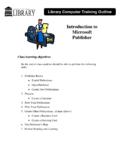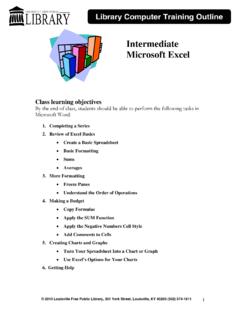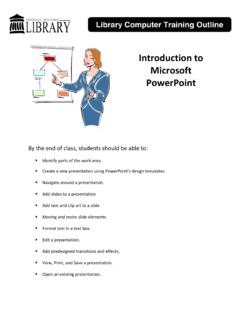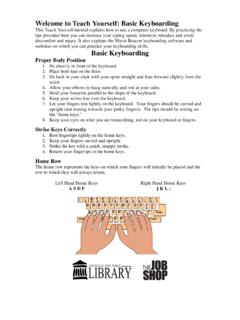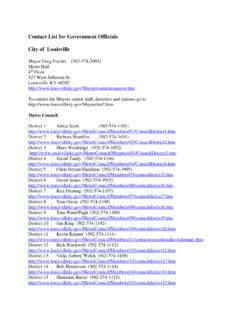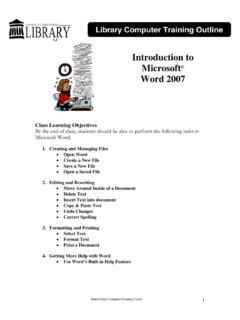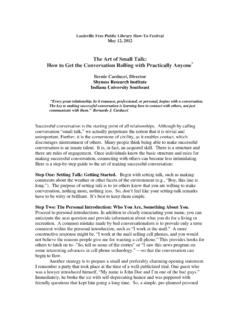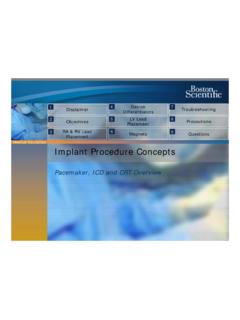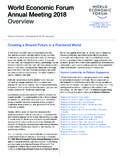Transcription of Introduction to Microsoft Excel 2007
1 Introduction to Microsoft Excel 2007 Class learning objectives 1. What is Excel ? Spreadsheet uses & samples Touring the Excel window Learning important definitions Navigating around the workbook 2. The Basics Entering & editing data in cells Inserting cells, rows, & columns Formatting cells Renaming, adding, & reorganizing worksheets 3. Formulas Using mathematical operators Using four sum methods AutoCalculate 4. Customizing Your Spreadsheet Gridlines 5. Finishing Up Using Excel s help More learning resources Main Library Computer Learning Center 1 What is Excel ? Excel is a spreadsheet program that can be used to organize, manipulate and analyze data. Excel is often used in the workplace to track statistics, create sales reports, financial modeling, scientific engineering, and making charts and graphics. However, it can also be useful at home to create budgets or even make a list of family members birthdays.
2 Excel is a versatile and powerful program with a lot to offer. The Excel Window When you first open up Excel you will see a blank sheet that looks a lot like a grid. If you have ever used other Microsoft programs such as Microsoft Word, you will recognize several parts already such as the Title Bar. Other parts might be unfamiliar, so let s look at the parts of an Excel window. Ribbon Tab Office 2007 Ribbon Formula Bar Name Box Column Names Row Names Active Cell Cells Worksheet Tabs Main Library Computer Learning Center 2 The Microsoft Office 2007 Ribbon Microsoft Office 2007 uses a visual tool called the ribbon to display all of the commands that are used to edit a document. The ribbon uses two different visual elements: tabs and command groups. 1. Each tab contains a set of groups that share a theme in common. The Home tab, for example, contains all of the commands that are used most often by most people.
3 2. Within each tab are groups of command icons that share a common design element. The Font group, for instance, contains all of the commands that change the way that text looks while the Number group contains commands that change the way numbers are displayed within a cell. 3. Finally, within each group are visual representations of the commands themselves. Cells The gray boxes that make up the Excel grid are called cells. Cells are arranged in rows and columns. They are used to store data. Data can be numbers, text and formulas, such as mathematical calculations. Active Cell The active cell is the cell you are currently working with. There is always an active cell on your worksheet. You can identify the active cell on your worksheet because it has a thicker border than the other cells and its name is listed in the cell name box. To change which cell is the active cell, simply click on it or move to it using the arrow keys on your keyboard.
4 Name Box The cell name box, located below the clipboard group in the ribbon identifies the name of the active cell. Cells are named by giving the column letter and then the row number. For example, B3 means the active cell is located in column B and is in the third row. Formula Bar The formula bar displays the contents of the active cell. This could be a formula, data or just text. Workbook An Excel file is called a workbook. It is helpful to think of a workbook as being like a notebook containing many sheets. Worksheets The individual pages in the workbook are called worksheets. They are often referred to as simply sheets. In addition to data, worksheets can also contain graphical objects, such as charts, Main Library Computer Learning Center 3 arrows and pictures. Each worksheet consists of a tabular grid of cells. There are more than 65,000 rows of cells, starting with number 1 along the left margin of the worksheet.
5 There are 256 columns along the top margin of the worksheet. These columns are labeled alphabetically, using a single-digit and then double-digit alphabetization scheme. Worksheet Tabs There is a tab in the bottom left corner of the Excel window for each sheet in your workbook. Clicking on a sheet s tab will take you to that sheet. Navigating Around the Workbook Excel has scroll bars to help you view all areas of a sheet quickly. You can click in a cell using your mouse to select a specific cell. Using the scroll bars and the mouse you can quickly select any cell in the worksheet. However, some users find it easier to move around in Excel using the keyboard instead of the mouse. The table below explains some keystrokes you can use to navigate around worksheets. This Keystroke MovesTAB key Move to the right to the next cell in the row. ENTER key Move to the cell in the column below. Shift+TAB Move to preceding cell.
6 Arrow keys ( ) Move right, left, up, and down (one cell at a time). CTRL+arrow keys Move to the edge of the current data region (region the cell is currently in). Home Move to the beginning of row. CTRL+Home Move to Cell A1. Entering and Editing Data Entering Data into a cell To enter data into a cell, simply do the following: 1. Select the cell by clicking on it. The cursor will not blink (as it does in Microsoft Word), but instead the cell will be outlined in a thick black line and it will be listed in the cell name field below the ribbon. These two things tell you that the cell is active and ready to accept a formula or text. 2. Type numbers, text, or a combination of both into the cell. 3. Press the Enter key OR click on the green check mark to the left of the Formula bar. Pressing Enter will enter the information into that cell and move you down to the next cell. Pressing the green check mark will enter your data but keep the same cell active.
7 Main Library Computer Learning Center 4 Create the spreadsheet below to practice entering data into a spreadsheet. Editing a cell: If you discover that you made a mistake when entering data into a cell, you can correct them within the formula bar or the cell itself. Formula Bar: Select the cell, then click in the formula bar. Make the needed correction. Then press Enter or click on the green check mark in the Formula bar. In the Cell: Either: o Select the cell and begin typing. What you type will erase the current information in the cell. -OR- o Double click on the cell. A cursor will appear in the cell. Move the cursor to where you need to make your changes. Make the changes. Then press Enter. Canceling/Undoing Changes Cancelling actions If you haven't yet pressed Enter while entering or editing information in a cell, press the Esc key or click on the X button on the formula bar. Undo/Redo Actions To Undo Your Most Recent Action Click the Undo button on the Standard Toolbar.
8 To Cancel Your Most Recent Undo Click on the Redo button on the Standard Toolbar. Clearing a Cell Main Library Computer Learning Center 5 Clearing a cell removes any data that is entered into the cell. The quickest way to clear a cell is to select one or more cells, then press the Delete key or the Backspace key. This clears the contents, but leaves formatting and other cell contents intact. To delete the cell entirely, click Edit on the main menu and select Delete. It will then ask you which way you would like to shift the other cells. Inserting Cells, Rows and Columns. Inserting a Cell 1. Click on the cell where you would like to insert a new cell. 2. On the Home tab, click on Insert in the Cells group and then click Insert Cells from the list of choices. 3. Click on the circle that indicates which direction you would like to shift the existing cells. Inserting a Row 1. Click on the row where you would like to insert a new row.
9 2. On the Home tab, click on Insert in the Cells group and then click Insert Rows from the list of choices. 3. A new row will be inserted above the row containing the current active cell. Inserting a Column 1. Click on the column where you would like to insert a new column. 2. Click on On the Home tab, click on Insert in the Cells group and then click Insert Columns from the list of choices. 3. A new column will be inserted to the left of the column containing the current active cell. Formatting Cells Selecting Cells Before making any formatting adjustments you must first select the cell(s) you want to change selected cells will have a dark border surrounding them. To select: a single cell, click on it. Nonadjacent cells can be selected by holding down the. a range of cells, click on a corner cell in the desired range, hold down your mouse button and drag your mouse pointer over the desired range of cells. Multiple ranges can be selected by holding down the CTRL key on your keyboard and selecting additional cell ranges.
10 All of the cells in a column, click on the column heading. all of the cells in a row, click on the row heading. all of the cells in a worksheet, press Ctrl + A on your keyboard OR click the square in the upper left corner of the worksheet to the left of column A s heading. Main Library Computer Learning Center 6 NOTE: Even when a range of cells is selected, one cell is still the active cell (the one in your selected area that did not turn blue). Using Office 2007 s Formatting Tools You can format the appearance of a cell, or range of cells, by selecting the cells you want to format and then make adjustments to them using the tools on the Office 2007 Ribbon. Font Size Vertical and Horizontal Text Alignment Formatting Numbers The default numbering format for numbers entered is the General format. In General format, the numbers appear exactly as you typed them into the cells. Sometimes it is useful to adjust the appearance of numbers to reflect the type of data that you are working with.
